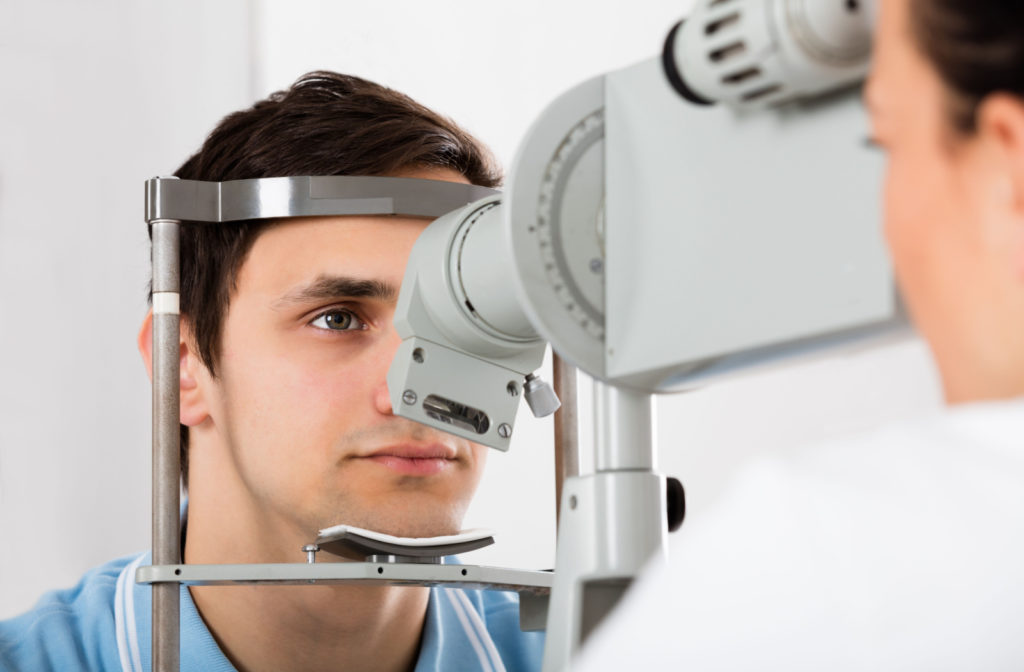If you struggle with dry eyes or are a contact lens wearer, you probably have a handy bottle of eye drops. But have you ever found yourself with dry, irritated eyes and no eye drops in sight?
A common question is: Can your trusty contact lens solution do double duty as eye drops?
You can’t use contact lens solutions as eye drops because they can contain ingredients that may cause irritation and redness in your eyes.
If you suspect an eye issue, such as dry eye, pink eye, or eye allergies, speak to your eye doctor before putting any solution in your eyes.
What Is Contact Lens Solution?
Contact lens solution is a sterile liquid designed for cleaning, disinfecting, and storing contact lenses. It can remove debris, protein deposits, and microorganisms from the lenses to help them remain comfortable and safe to wear.
Multipurpose Contact Lens Solution
As the name suggests, a multipurpose contact lens solution is an all-in-one product that cleans, rinses, disinfects, and stores your contact lenses. Some types come with or without moisturizers.
Hydrogen Peroxide Contact Lens Solution
Hydrogen peroxide solution also cleans, disinfects, and stores your contact lenses. Generally, eye care professionals recommend it to individuals who react to a multipurpose contact solution.
Is It Safe to Use Contact Solution as Eye Drops?
While contact solution works with contact lenses, no studies or tests indicate their direct use in the eyes. The ingredients in contact solution are mainly for cleaning and disinfecting lenses and are not supposed to be applied to delicate eye tissues.
Some people may be sensitive or allergic to certain ingredients in the solution, which could further exacerbate the discomfort. It’s vital to prioritize your eye health and use products approved for your contact lenses and eyes.
Ingredients in Contact Lens Solution
Most contact solutions contain a combination of water, saline solution, and various disinfecting agents. Multipurpose contact lens solution contains the disinfectants chlorhexidine, polyaminopropyl biguanide (PAPB), and the antibacterial preservative ethylenediaminetetraacetic acid (EDPA). All are effective against germs that can lead to eye infections and other eye conditions.
Hydrogen peroxide is the main ingredient in hydrogen peroxide solution. Even though the hydrogen peroxide is converted to saline in a few hours after placing it in a case, you should avoid any contact with or near your eyes as it can cause the following symptoms:
- Stinging
- Burning
- Irritation
- Eye pain
- Injury
The Difference Between Contact Solution & Eye Drops
The primary difference between contact solution and eye drops is their purpose and composition. As mentioned earlier, contact solution contains disinfecting agents not found in standard eye drops.
Eye drops, on the other hand, are formulated with specific ingredients to alleviate dryness, redness, and irritation in the eyes. They are sterile and safe for direct application in the eyes, making them the ideal choice for addressing the above issues.
There are various types of eye drops available, including:
- Lubricating drops or artificial tears: These can be preservative or preservative-free and mimic the natural tears to provide moisture to the eyes and thus provide relief from dry eye symptoms.
- Allergy drops: Includes decongestant and antihistamine eye drops to help control allergy symptoms.
- Medicated drops: Prescription eye drops can help with inflammation, tear production, and infection for specific eye conditions.

What to Do If You Experience Eye Discomfort
If you’re experiencing dry, itchy, or irritated eyes, resist using contact solution as a quick fix. Instead, consider the following:
- Remove your contact lenses: If you wear contacts and your eyes feel uncomfortable, take them out immediately and contact your eye doctor. Continuing to wear them may worsen the irritation.
- Wash your hands: Before touching your eyes, wash your hands thoroughly with soap and water to avoid introducing additional contaminants.
- Use proper eye drops: Before you reach for any over-the-counter eye drops, ask your eye doctor which artificial tears or lubricating drops to use in your eyes.
- Visit your eye doctor: If your symptoms persist or worsen, immediately schedule an appointment with your eye doctor. They can conduct an eye exam, identify the underlying cause of your discomfort, and recommend the most appropriate treatment.
Eye Health & Comfort
While it’s easy to use contact solution as eye drops in a pinch, it’s not a safe or recommended practice. Contact solution cleans and disinfects contact lenses; it doesn’t lubricate the eyes.
For superior eye health and comfort, always use eye drops meant for ocular use and your eyes. If you experience persistent or severe eye discomfort, book an appointment with Total Vision Sports Arena to address the issue effectively and safely.



